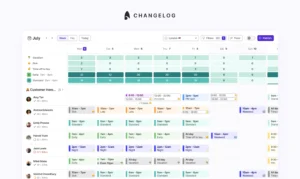
A complete guide to call centre forecasting in 2024

We know that call centres face dynamic demands which is why forecasting is so critical to improving predictability in an uncertain environment.
If you’ve ever worked with an eCommerce business, then you know that Mondays and Thursdays (8-9 pm) are noisier than weekends. Equally, if you work in insurance that overnight demands come through at less sociable times.
So, if you do not have enough agents during peak times, you may end up frustrating customers with long wait times and substantial email backlogs.
This is where the role of effective call centre forecasting comes in.
Accurate forecasting enables call centres to allocate resources and staff based on demand, ensuring optimal customer service levels and minimum operational costs.
Here’s a comprehensive guideline on call centre forecasting that can guide you to better productivity and customer satisfaction in 2024.
What is call centre forecasting?
Call centre forecasting predicts the volume of customer interactions a call centre will likely receive during a specific period. It helps call centres plan staffing, resources, and technology to handle the expected volume while providing quality service.
When it comes to call centre forecasting, accuracy is the name of the game. It is the key to unlocking the ability to adjust staffing levels and allocate resources in real-time, which is critical when dealing with unexpected changes in call volume.
Through accurate call centre volume forecasting, call centres can handle even the busiest of times without sacrificing the quality of customer service.
Here are a few call centre forecasting fundamentals you must know about.
Workload forecasting
Workload forecasting predicts the amount of work a team or organisation will likely receive during a specific period. It involves analysing historical data, trends, and other relevant factors to estimate the expected workload and allocate the necessary resources to ensure the organisation can handle the workload efficiently and effectively.
Here are a few relevant factors to consider for accurate workload forecasting.
Forecast duration
Forecast duration is the length of time for which a forecast is made. The call centre forecast duration is typically based on the call centre’s operational needs and can vary from hourly to annual intervals.
Here’s a quick look at call centre forecasting methods for short, medium, and long-term planning.
| Planning | Time Horizon | Purpose | Examples |
|---|---|---|---|
| Short-term planning | Hours to days | Staffing decisions for upcoming shifts or days | Determining the number of agents needed to handle calls for the next few hours, adjusting staffing levels to meet unexpected call volume changes |
| Medium-term planning | Weeks to months | Resource planning and schedulingResource planning and scheduling | Determining staffing levels, scheduling training, capacity planning, budgeting, and planning for future events such as holidays or promotions |
| Long-term planning | Years to multiple years | Strategic planning and budgeting | Planning for expansion, investment decisions, and forecasting long-term call volumes. |
Call volumes
Call volume is a crucial factor in accurate workload forecasting for call centres.
Here are a few factors that call centres need to consider to forecast unpredictable call volumes accurately.
Historical Data: Call centres can use historical data to identify patterns and trends in call volumes. By analysing past call volume data, call centres can identify seasonal fluctuations and trends, enabling them to adjust staffing levels accordingly.
Marketing Campaigns: Call centres may experience increased call volumes due to running marketing campaigns such as product launches or promotions. Hence, knowing about the upcoming marketing campaigns is significant to planning and handling the increased call volumes.
Regular Events: Call centres may experience a drop in call volumes on weekends as customers may have more free time to research or resolve issues online. On the other hand, holidays like Mother’s Day can shoot up call volumes as customers may need assistance with purchases or delivery.
Average handle times
Average Handle Time (AHT) refers to an agent’s time on a call, including speaking with the customer, placing the customer on hold, and completing any necessary follow-up tasks after the call.
Below are a few factors to consider various for forecasting AHT accurately👇
- Call Type: Different call types can have different AHTs. For example, a customer calling to report a technical issue may require more time than a customer calling to place an order.
- Customer Behaviour: Customer behaviour can also impact AHT. For example, a customer who is frustrated or angry may require more time to resolve an issue than a calm and cooperative customer.
- Agent Performance: Agent performance can also impact AHT. Highly skilled agents may be able to resolve issues more quickly, while less experienced agents may require more time.
- System Performance: Similarly, slow or inefficient software can extend the call time.
Service level goal
The service level goal refers to the percentage of calls answered within a certain time. Accurately forecasting the service level goal ensures the call centre can handle the expected call volume within the desired service level.
To accurately forecast the service level goal, call centres need to consider staffing levels, call volumes, AHT, and customer expectations that can impact the number of calls answered within the desired time frame.
Workforce forecasting
Workforce Forecasting is predicting the number of workers required to handle future demand for call centre services.
Efficient workload scheduling in call centre forecasting plays a crucial role by precisely aligning agent availability with incoming call volumes, resulting in maximized resource utilization and elevated customer service standards.
Considering the following factors can lead to much more accurate workforce scheduling & forecasting.
Find total workers
The first step in workforce forecasting is determining the total number of workers needed to handle the forecasted call volume.
This calculation typically considers historical call volume data and predicted call volume trends.
Other factors impacting the total number of workers needed include service level goals, target handle times, and agent productivity levels.
Calculate FTEs
FTE stands for “full-time equivalent” and is a measure of a worker’s employment status that indicates how much of a full-time job they represent.
This calculation typically considers the number of hours worked by each agent, as well as any part-time workers or job-sharing arrangements.
For example, let’s say an employer follows a 40-hour workweek. To calculate the Full-Time Equivalents (FTEs) for an employee with a scheduled 30 hours per week, divide the employee’s scheduled hours by 40.So, an employee working 30 hours per week would be 0.75 FTE when the full-time workweek is 40 hours.
Adjust for attrition
Call centres typically adjust their workforce forecasting to add workers to the total FTEs needed to handle the forecasted call volume to account for attrition.
The number of additional workers required depends on the call centre’s historical attrition rate and other factors that may impact turnovers, such as job satisfaction and compensation.
Adjusting the workforce forecast for attrition helps ensure that you have enough workers to handle the call volume.
How to build a call centre forecasting model?
For starters, here are two steps to building a call centre forecasting model.
- Collecting a substantial amount of data for creating a predictive model
- Then, calculate the metrics required for forecasting – call volumes, average handle times, service level goals, and staffing levels.
You have three major approaches to creating call centre forecasting models in 2024.
| Model Nature | How to build this call centre forecasting model?v |
|---|---|
| 1st Approach – Assume that each day will follow the pattern of the corresponding day in previous historical data. | Analyse the call volume of the past four Mondays to create a forecast for the upcoming Monday. If the average call volume has been 200 calls, estimate receiving around 200 calls on the upcoming Monday Analyse the call volume of the past four Mondays to create a forecast for the upcoming Monday. If the average call volume has been 200 calls, estimate receiving around 200 calls on the upcoming Monday |
| 2nd Approach – Factor in call traffic changes over time. | Look at the previous year’s data and note a 20% increase in calls during the last week of December. Use this information to predict that you will receive 20% more calls during that period than during the rest of the holiday season. |
| 3rd Approach – Analyse the call volume on historical dates over several years and determine the average. Use it as a baseline for forecasting. | Look at the call volume from the past five summers and determine the average number of calls received. If the average is 500 per day during the summer months, consider it a baseline to forecast that you will receive about 500 calls per day in the upcoming summer months. |
💡Pro-Tips
- Adjust the forecast for public holidays and other events, such as product launches, that may affect call volume, regardless of your chosen forecasting method.
- Make predictions for complete days and specific hours within those days. Test their accuracy by comparing them to the actual call centre traffic during a set period.
- Use multiple call centre forecasting methods to increase the accuracy of predictions.
- Regularly update the forecasting model with new data and consider different call centre forecasting techniques to see which ones work best for you. Adjust predictions as necessary.
- Use technology and tools, such as workforce management software, to automate the forecasting process and make it more efficient.
Challenges and solutions for call centre forecasting in 2024
To ensure that your forecasting is effective and accurate, we have listed a few common challenges (with solutions) to help you out. Take a look –
New product launch
New product launches can be challenging in call centre workforce management forecasting as they often increase call volume and can lead to unpredictable customer behaviour.
For instance, the technology, healthcare, and financial services industries face greater challenges in call centre forecasting during a new product launch as their products require more understanding.
Here are a few solutions to address this challenge of call centre forecasting in 2024.
- Gather data and insights from previous product launches and adjust forecasts accordingly.
- Monitor call centre metrics in real-time and make adjustments to optimise performance.
- Continuously review and adjust forecasting methods based on actual call volume and customer behaviour.
Seasonal spikes
Seasonal spikes refer to predictable periods of increased demand or activity in a particular industry or market that occur regularly, typically at the same time each year.
According to Gartner, call centres face intense spikes of up to 10 times normal call volumes during holidays, promotional events, and vacations.
Here’s how you can handle spikes.
- Review historical call data from previous seasonal spikes. It can help identify patterns and trends, allowing for more accurate forecasting and staffing decisions.
- Implement the right workforce management software. It can help optimise staffing levels, forecast call volume, and monitor performance in real-time, allowing for quick adjustments.
Unforeseen events
Unexpected events can significantly impact call volume and staffing needs in call centre forecasting. They include sudden changes in customer behaviour, resource constraints, uncertainty, and more.
To prepare for unforeseen events, utilise historical data from remotely related similar situations to develop a predictive strategy or to visualise potential outcomes. Ensure that predictable variables are factored into the analysis.
Tips to improve call centre forecasting
Here are a few practical tips to help call centre managers to improve their forecasting accuracy and optimise call centre forecasting operations in 2024.
Control shrinkage
Shrinkage happens when agents are not available to handle calls. They may be on breaks, meetings, training, and other non-productive activities.
To improve call centre forecasting in 2024, it is essential to control shrinkage and minimise its impact on call volumes.
Call centres can accomplish this by the following methods.
- Track and manage shrinkage
- Set realistic shrinkage targets
- Incentivize agents to adhere to shrinkage targets
- Provide training and coaching to help agents manage their time effectively
- Implement flexible scheduling options, such as part-time or remote work, to reduce the impact of shrinkage on call volumes.
Equip agents with the right tools
Providing call centre agents with the right tools and resources is critical to success. Call centres can improve their forecasting accuracy, reduce call handling times, and enhance the overall customer experience with the right resources.
For instance, agents need access to accurate and up-to-date information, knowledge repositories, customer data, and analytics to handle customer inquiries effectively.
Handle non-call work
Non-call work activities include breaks, training, coaching sessions, administrative work, and other tasks. Call centres must account for non-call work and factor it into their process to improve call centre forecasting accuracy. It can help ensure that agents handle calls during peak periods and that service levels are maintained even when agents engage in other non-call activities.
With Surfboard, you can automatically assign your team’s shifts 8 weeks in advance. Hence, they know when they’re working, allowing agents to manage their work efficiency while accounting for non-call work activities.
- You can use Surfboard Shift Plans to quickly adapt your schedule while considering time zones, rotations, and time offs.
- Surfboard’s round-robin scheduling tool fairly distributes shifts across team members, reducing burnout and increasing morale.
- You can set up different global shifts in a few clicks and remove the chaos of managing different time zones.
- Make tweaks and edits, and accommodate for time off in draft mode.
Use blending techniques
Call centre forecasting should not be limited to call volume prediction alone. Forecast non-call volumes, such as emails, chats, and social media messages, to improve accuracy.
By using blending techniques that consider both call and non-call volumes, call centres can better predict the overall volume of customer interactions and allocate resources accordingly. This approach helps
- reduce wait times,
- improve agent productivity, and
- enhance customer experience.
Additionally, call centres can use automated tools, like chatbots and self-service portals, to handle non-call volumes, further reducing the impact of these interactions on resources.
Wrapping up
Achieving accurate call centre forecasting and seamless operations is no easy task. But workforce management software can be your savior.
Choose a call centre forecasting software that’s user-friendly and consider how configurable the forecasting engine is to account for changing conditions.
In short, let Surfboard handle the heavy lifting and save you time.
Surfboard can take care of all your call centre forecasting needs. You can have the right people in the right place at the right time, ensuring your SLAs and cost goals are easily met.
Our user-friendly platform provides effortless inflow forecasting, shift scheduling, and activity delegation based on historical data. Moreover, with the seamless integrations and the new clock-in clock-out feature, managing your customer support team gets easier.
Sounds useful? Book a demo now.
FAQs
What are 3 popular forecasting techniques?
Three popular forecasting techniques:
- Time-series forecasting based on past data patterns.
- Factoring in changes in call traffic.
- Analysing call volume over several years and determining the average for forecasting.
How do you forecast volume in a call centre?
Call centre volume can be forecasted by analysing historical data, identifying trends and patterns, and considering external factors such as holidays or marketing campaigns. Statistical modelling and forecasting techniques can also be used.



